Tai Chi Chuan
Classical Yang Style
Dr. Yang, Jwing-Ming
Tai Chi Chuan
Classical Yang Style
The Complete Long Form and Qigong
YMAA Publication Center
Wolfeboro, N.H., USA
YMAA Publication Center
Main Office: PO Box 480
Wolfeboro, NH 03894
1-800-669-8892
ISBN-13: 978-1-59439-200-9
ISBN-10: 1-59439-200-5
All rights reserved including the right of reproduction in whole or in part in any form.
Copyright 2010 by Yang, Jwing-Ming
Cover design by Axie Breen
Edited by James OLeary, Jr., with contributions to this revised edition by Dolores Sparrow and Ken Craggs
10 9 8 7 6 5 4 3 2 1
Publishers Cataloging in Publication
The authors and publisher of this material are NOT RESPONSIBLE in any manner whatsoever for any injury which may occur through reading or following the instructions in this manual.
The activities, physical or otherwise, described in this material may be too strenuous or dangerous for some people, and the reader(s) should consult a physician before engaging in them.
Printed in Canada
To a Great Taiji Spiritual Teacher and FatherJou, Tsung Hwa
Deeply inside, I am experiencing unlimited and uncontrollable sorrow.
Master Jou, such a great taiji teacher, passed away so suddenly from an accident. Although it is so sad to look back now to those happy days when I received your teaching and caring, and I know you would be so disappointed that you cannot fulfill your dream to demonstrate your will and capability of living 150 years, still I can remember how everyone saw you grow younger and younger, your spirit becoming stronger each year. All of us, your students and spiritual children of the Taiji Farm, were convinced that through practicing and understanding taijiquan, we could live for a long time with a healthy body and happy mind, just like you. Countless taiji practitioners came each year to your creation, the Taiji Farm, to share your spirit and admire your will power and living force. Like a modern day roundtable of taiji, the Taiji Farm taught us to put aside our differences and petty jealousies and absorb from you your life experience and profound wisdom. Together we learned how to take care of our bodies through practicing taijiquan and qigong, and most importantly of all, we learned that the true journey of our art is the reevaluation of the meaning of our life and an appreciation of the energies that taiji makes visible to our senses. This was your gift to us, to the taiji society, and to the human race.

I feel such a sudden sense of loss, which I know I share with so many. I have appreciated every second we spent together, and I quietly listened to your life philosophy and taiji experience at every opportunity. It is hard for me to accept that you will not be there for further discussions and good-natured arguments about lifes different viewpoints. I will miss you whenever the word of taiji appears in my mind. I will never stop talking about the legacy of your life and existence. As I have promised you, I will continue in the promotion of taijiquan, although I know that without you, the burden will be so much greater. I acknowledge my obligation to you, and I promise that as long as I live, I will continue to share what I know without hesitation. Your spirit is my spirit, and the goal of your life is my goal. I only wish the life I can offer, the example I can provide, could be as rich and meaningful as the one that you provided to all of us. I cannot express with words how much I will miss you. But I know that your spirit will live forever and that your name and your story will continue to inspire taiji practitioners far into the future.
Dr. Yang, Jwing-Ming
August 4, 1998
Using the book and DVD together . Throughout this book, you will see this icon on certain pages. The DVD icon tells you that companion material is found on the DVD. The larger words indicate the type content (e.g. lecture, follow along, etc.), the smaller words indicate the precise menu selection you should choose in the DVD.
Romanization of Chinese Words . This book primarily uses the Pinyin Romanization system of Chinese to English. Pinyin is standard in the Peoples Republic of China, and in several world organizations, including the United Nations. Pinyin, which was introduced in China in the 1950s, replaces the Wade-Giles and Yale systems. In some cases, the more popular spelling of a word may be used for clarity.
| Some common conversions: |
| Pinyin | Also Spelled As | Pronunciation |
| Qi | Chi | ch |
| Qigong | Chi Kung | ch gng gng |
| Qin Na | Chin Na | ch n n n n |
| Jin | Jing | j n n |
| Gongfu | Kung Fu | gng foo |
| Taijiquan | Tai Chi Chuan | t j j chn chn |
For more information, please refer to The Peoples Republic of China: Administrative Atlas, The Reform of the Chinese Written Language , or a contemporary manual of style.
The author and publisher have taken the liberty of not italicizing words of foreign origin in this text. This decision was made to make the text easier to read. Please see the comprehensive glossary for definitions of Chinese words.
Contents
Grandmaster Jou, Tsung Hwa
In 1985, I wrote a foreword for Dr. Yang when the first edition of his book, Advanced Yang Style Tai Chi Chuan , vol. 1, was published. Time flies like an arrow, and already fourteen years have passed. During this period, Dr. Yang has published many more books and videos related to Chinese martial arts and qigong. In addition, he has been offering wushu and qigong seminars and workshops every year in America, Europe, Africa, South America, and the Middle East.
It is said in Chinese society that Even separated for three days, we should see each other differently. This is really true. Dr. Yang, after more than ten years of further study and in-depth research, together with his abundant teaching experience, has written this new book, Tai Chi Chuan, Classical Yang Style. He asked me to write a foreword for him again.
Taijiquan has spread throughout the entire world. Millions of people now practice it. Unfortunately, I believe that almost all the essence of taijiquan has also been gradually lost. Take a look at Wang, Zong-yues Taijiquan Classics , where it is said: There are many martial art styles. Although the postures are distinguishable from one another, after all, it is nothing more than the strong beating the weak, the slow yielding to the fast. The one with power beats the one without power; the slow hands yield to the fast hands. All this is natural born ability. It is not related to the power that has to be learned. If we look at most of todays taijiquan tournaments, havent they entered the side door, that is, the wrong path? Again, let us read the following sentence from Wang, Zong-yue, where it is said: Consider the saying: Four ounces repels one thousand pounds. It is apparent that this cannot be accomplished by strength. Look, if an eighty- or ninety-year-old man can still defend himself against multiple opponents, it cannot be a matter of speed. Therefore, if we truly wish to learn the real taijiquan, we must free ourselves from the prisons of muscular power (
Next page

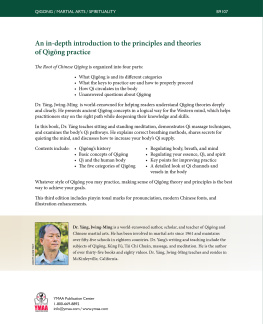
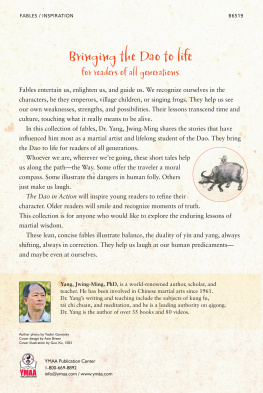
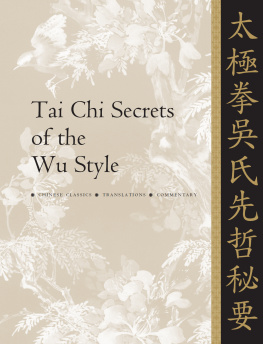
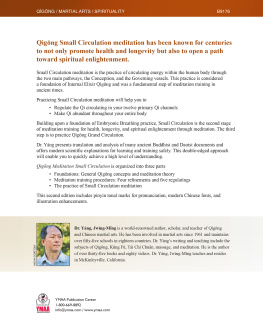

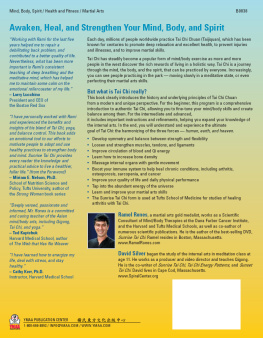
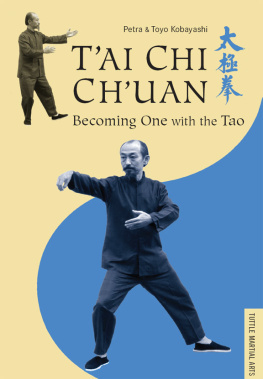
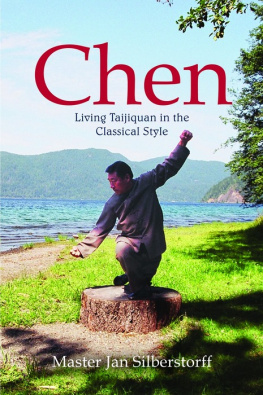
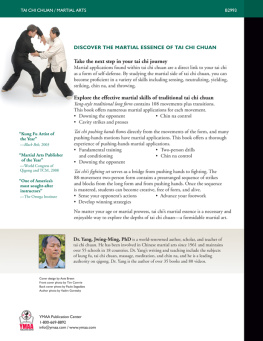
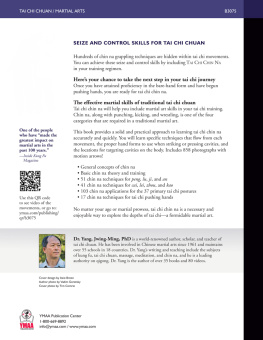


 n n
n n
 j
j